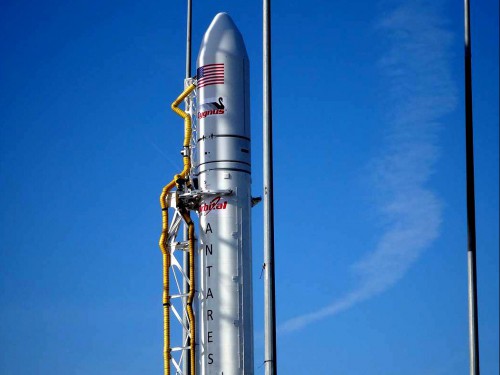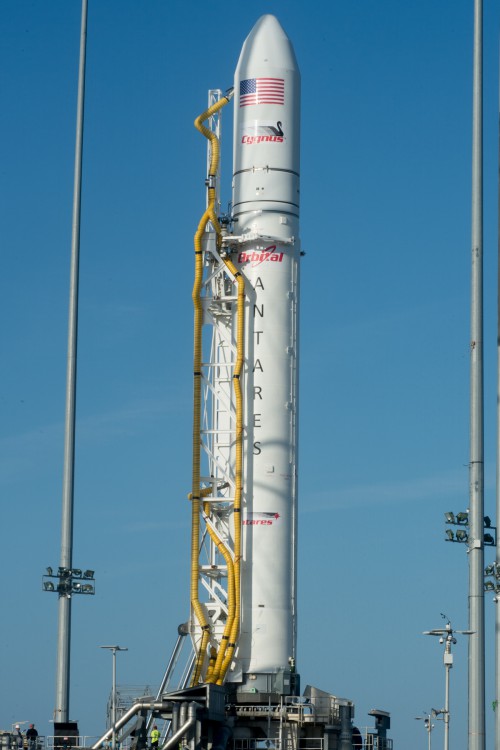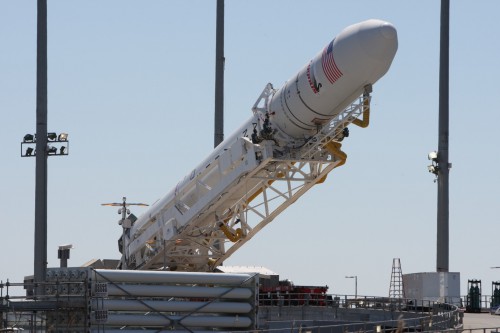
Despite fluctuating worries about cloudy weather conditions, it was the premature separation of a loose second-stage umbilical which ended today’s attempt to get Orbital Sciences’ new Antares rocket into orbit on its “A-ONE” maiden voyage. The countdown to launch from Pad 0A at the Mid-Atlantic Regional Spaceport (MARS) on Wallops Island, Va., proceeded normally until less than 30 minutes before the scheduled 5:00 p.m. EDT liftoff time, when “an anomaly” was noted and the long-awaited launch was called off. Early indications are that a delay of perhaps 48 hours will be necessary to ready Antares for another attempt, although this has yet to be officially confirmed.

Following a successful hot-fire test of A-ONE’s AJ-26 engines on 22 February, and the rollout of the two-stage rocket to Pad 0A, on 6 April, preparations for the launch proceeded with exceptional smoothness. Late last night, the Antares vehicle team completed their final arming and closeout activities and the ‘call to stations’ of all personnel was performed at 8:45 a.m. EDT Wednesday. Right from the outset, however, there were doubts about the weather, with broken cloud ceilings at low altitude and only a 45-percent probability of acceptable conditions by the scheduled opening of the launch window at 5:00 p.m. Even tomorrow’s forecast does not look much better and is presently estimated to be only 50-percent acceptable for Antares to fly.
“We are of course disappointed, we weren’t working any issues on the pad and we were very much looking forward to launch and then we had the issue on the umbilical occur,” said Orbital Spokesperson Barry Beneski. “This is as much information as we know right now, and again, this is not overly surprising, I don’t think we should be shocked that this happened, first time for the rocket, first time for the pad. So, while its disappointing, we’re going to try again.”
As the morning wore into the afternoon, the situation remained balanced on a knife-edge, although Orbital managers elected to proceed and the vehicle and payload avionics were powered-up and transferred to internal power. At 3:30 p.m. final polling led to a decision to press on with fueling the giant rocket’s first stage with a rocket-grade form of kerosene (known as ‘RP-1’), followed shortly afterwards by the loading of liquid oxygen. The launch window, which had already been adjusted to 5:00-7:00 p.m., was shortened to occur within a 15-minute block at the start of this period. By 4:00 p.m., the propellant tanks for Antares’ twin AJ-26 first-stage engines were fully-fueled and weather conditions had improved slightly to 60 percent. The premature separation of an umbilical from the rocket appears to have occurred within the final stages of the countdown.
The “A-ONE” mission is a test of the 133-foot-tall booster, whose most high-profile future role will be to support eight voyages of the Cygnus cargo craft to the International Space Station. Aboard Antares are a quartet of tiny ‘picosatellites’ in a dispenser, as well as a full-size, 8,400-pound mass simulator of Cygnus itself. Orbital Sciences – which won a $1.9 billion share of NASA’s Commercial Resupply Services contract, back in December 2008 – has much to prove and is faced with the daunting challenge of regaining ground already lost to its CRS competitor, SpaceX.

Although A-ONE is a bare-bones evaluation of the new system, it is hugely significant for Orbital, which celebrated its 30th anniversary last year, and Antares represents its first cryogenically-propelled rocket. Its first stage is fed by a pair of Aerojet-built AJ-26 engines, developed from Soviet-era NK-33 powerplants, whose own heritage extends back to the ill-fated N-1 lunar booster of the 1960s. Fueled by rocket-grade kerosene (RP-1) and liquid oxygen, a total of 36 of these engines were purchased by Aerojet from Russia in the mid-1990s, at a cost of $1.1 million per unit. Each engine produces a sea-level thrust of 338,000 pounds and their performance on the test stand has been generally good, with the exception of a June 2011 kerosene fire, caused by stress-corrosion cracks in the 40-year-old metal.
If Antares’ development has been problematic, then so too has the process to build the MARS site, which Orbital’s President and CEO David Thompson described as “the first all-new, large-scale liquid-fuel launch site to be built in the U.S. for decades”. As part of the redevelopment of the site, Pad 0A was completely demolished, to make way for an entirely new facility with sophisticated kerosene and liquid oxygen tankage, but difficulties were experienced along the way, most notably with the propellant-handling equipment. This has conspired to push back the maiden voyage of Antares, and the first flight of Cygnus, by well over a year.
In the meantime, SpaceX – which won a $1.6 billion slice of the CRS pie – has tested its Falcon 9 booster, flown an inaugural demo mission of its Dragon craft to the International Space Station and staged two further operational cargo flights. Today’s scrub will come as a bitter disappointment for Orbital, although if the company achieves success in the next few days its hope – published on its website – to stage a Cygnus test flight to the space station “around mid-year”, may still be a realistic possibility.
“We are still examining all of the data, but it appears that the issue is fairly straightforward,” said Orbital’s Executive Vice President and Mission Director for the Antares Test Flight, Frank Culbertson, “With this being the first launch of the new system from a new launch facility we have taken prudent steps to ensure a safe and successful outcome. Today, our scrub procedures were exercised and worked as planned. We are looking forward to a successful launch on Friday.”
Want to keep up-to-date with all things space? Be sure to “Like” AmericaSpace on Facebook and follow us on Twitter:@AmericaSpace
Missions » ISS » COTS » Missions » A-ONE »




2 Comments
2 Pings & Trackbacks
Pingback:Orbital’s Antares Rocket Targeted for Saturday Launch Attempt « AmericaSpace
Pingback:Orbital’s Antares Rocket Targeted for Saturday Launch Attempt – Wired4Space